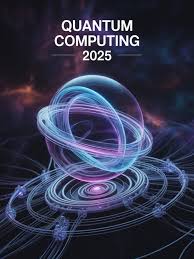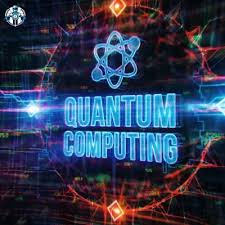Introduction
Have you ever wondered how the rules of reality become delightfully strange when computing is reduced to the size of atoms? Imagine a computer so powerful that it could solve puzzles that would take your laptop a billion years in a matter of seconds. It’s quantum computing, not science fiction! Experts estimate that the quantum computing sector could reach an astounding $1.3 trillion by 2035, revolutionizing everything from finance to medicine.
Not merely a catchphrase, quantum computing is a revolution driven by the peculiar laws of quantum mechanics. Superposition is a mind-bending technique that allows quantum computers to use qubits that can be both 0 and 1 at the same time, unlike your trusty smartphone, which plods along with bits that are either 0 or 1. When you combine entanglement—in which particles behave like cosmic best friends and instantly exchange secrets—you have a machine that has the potential to outperform traditional computers in ways that are almost magical.
Whether you’re a tech-inclined retiree, a busy parent, or an inquisitive teenager, quantum computing is poised to transform our world. It’s the best brainiac tool for everything from creating life-saving medications to deciphering impossible codes. Come along as we explore what quantum computing is, how it operates, and why it’s so exciting to everyone from CEOs to scientists. You may even feel as though you’ve had a glimpse of the future by the end!
Quantum Computing Basics
Without getting bogged down in technical jargon, let’s demystify quantum computing. Think of your average computer as a dependable old car that gets you from point A to point B, but it can’t compete with a jet in any races. Contrarily, quantum computing is that jet, speeding through computations by taking advantage of the strange behavior of subatomic particles.
Fundamentally, quantum computing is based on quantum mechanics, which is the physics of the extremely small, where objects behave differently than they do in the real world. Dancing with probabilities is more important than simply flipping switches. This enables quantum computers to solve issues like deciphering encryption codes and simulating intricate molecules that plague classical computers.
Quantum Mechanics Intro
The law governing particles such as electrons and photons is known as quantum mechanics. Quantum particles are capable of existing in multiple states simultaneously, unlike a soccer ball, which is either here or there. Until you check your phone, it seems as though it could be both on and off. The foundation of quantum computing is this strangeness.
Chemical reactions, for instance, are difficult for traditional computers to model because the variables increase exponentially. However, these interactions can be naturally modeled by quantum computing, which could transform domains such as drug discovery. Giving a chef a magical stove that cooks every dish at once is analogous to that.

Qubits vs. Bits
The qubit, short for quantum bit, is the mainstay of quantum computing. Like a light switch, classical bits are binary—0 or 1. However, superposition allows qubits to be 0, 1, or a combination of both. Consider a qubit as a coin that spins and is both heads and tails until it lands, whereas a bit is a coin that is either heads or tails.
Quantum computers can process exponentially more data thanks to this capability. A quantum computer could represent more states than there are atoms in the observable universe with only 300 qubits. It’s a game-changer for intricate simulations, but it’s not too much for your Netflix queue.
Here’s a quick comparison:
| Feature | Classical Bits | Quantum Bits (Qubits) |
|---|---|---|
| State | 0 or 1 | 0, 1, or superposition |
| Processing | Sequential | Parallel via quantum mechanics |
| Power | Great for simple tasks | Ideal for complex problems |
| Stability | Highly stable | Sensitive to environment |
Classical vs. Quantum
Emails, spreadsheets, and cat videos are all handled by traditional computers. Their methodical approach to tasks is acceptable until you encounter issues involving billions of variables, such as molecular modeling or weather forecasting. In contrast, quantum computers are perfect for certain, high-complexity tasks because they use qubits to investigate multiple solutions at once.
Consider a quantum computer as a flock of birds simultaneously scouting every trail, whereas a classical computer is a lone hiker plodding along one path. However, quantum machines are specialized tools for specific problems; they won’t replace your laptop.
How Quantum Computing Works
Let’s now examine quantum computing in more detail. It all comes down to using quantum gates to manipulate qubits by taking advantage of two important phenomena: entanglement and superposition. These make it possible for quantum computers to do calculations in ways that are unthinkable for classical systems.
Consider figuring out a huge jigsaw puzzle. One piece at a time, a traditional computer tries. A computer that is quantum? It’s similar to throwing everything into the air and seeing it come together flawlessly. This is how it accomplishes that feat.
Superposition Magic
The quantum superpower known as superposition enables qubits to exist in multiple states at once. One qubit can be either 0 or 1, or it can be a mix, similar to how notes blend in a musical chord. The possibilities are endless when you stack more than one qubit; 10 qubits can simultaneously represent 1,024 states.
Because of this, quantum computing is particularly good at solving optimization problems, such as figuring out the quickest way to deliver something across a city. By breaking RSA encryption in minutes rather than millennia, algorithms like Shor’s, which factor large numbers rapidly, have the potential to revolutionize cryptography.
A qubit’s superposition collapses to a single state when it is measured, though. Like tuning a radio to the clearest signal, quantum algorithms deftly postpone this collapse and use interference to magnify the right answers.
Entanglement Explained
It gets really eerie when you’re entangled. When qubits become entangled, their states are linked, so changing one instantly affects the other, even across vast distances. Although Einstein disliked it and referred to it as “spooky action at a distance,” it is powerful and real.
Entanglement generates correlations that accelerate calculations in quantum computing. Entangled qubits, for example, can simultaneously optimize interrelated variables in logistics, such as time, fuel, and traffic. It is comparable to a group of telepathic planners who are in unison.
Quantum Gates Role
Quantum gates are the tools that manipulate qubits, akin to logic gates in classical computing but with a quantum twist. Unlike classical gates, they’re reversible, preserving quantum states. Common gates include:
- Hadamard Gate: Creates superposition, putting qubits in a 0-and-1 state.
- CNOT Gate: Entangles qubits, linking their fates.
- Phase Gate: Tweaks qubit probabilities for fine-tuned algorithms.
String these gates into circuits, and you’ve got a quantum algorithm. Think of gates as chefs tossing ingredients into a quantum smoothie—blend them right, and you get a computational masterpiece.
Quantum Computing History
Quantum computing’s journey began in the 1980s, sparked by visionary physicists dreaming of machines that mimic nature’s quantum quirks. It’s gone from chalkboard theories to lab prototypes, with milestones that keep the tech world buzzing.
Early Ideas
Since classical computers were too slow for simulating quantum mechanics, Richard Feynman proposed using quantum systems in 1982. “Dammit, nature isn’t classical,” he famously joked. The foundation for quantum computing was laid by this concept.
David Deutsch demonstrated that a universal quantum computer could theoretically outperform a classical one by formalizing the idea in 1985. These initial concepts were akin to drawing a rocket before anyone understood how to construct one.
Key Milestones
There were breakthroughs in the 1990s. Modern encryption was threatened in 1994 when Peter Shor developed an algorithm that could factor large numbers exponentially faster. The first 2-qubit quantum computer, a cumbersome proof-of-concept, was constructed in 1998.
In 2019, Google asserted “quantum supremacy” after its Sycamore processor solved a problem in 200 seconds that would have taken 10,000 years for a supercomputer to solve. Although the claim was contested, it was a watershed.

Current Quantum Advances
We’re in the Noisy Intermediate-Scale Quantum (NISQ) era—think of it as quantum computing’s awkward teenage phase. Machines have 50–200 qubits but are error-prone. Still, progress is dazzling.
Key Players Today
Tech giants like IBM, Google, and Microsoft are racing alongside startups like Rigetti, IonQ, and D-Wave. IBM’s Qiskit platform lets developers tinker with quantum computing via the cloud, making it accessible to curious coders.
Governments are all in—China invested $15 billion by 2022, while the U.S. and EU fund national quantum initiatives. It’s a global sprint for quantum dominance.
Quantum Hardware Types
Quantum hardware comes in flavors, each with trade-offs:
- Superconducting Qubits (IBM, Google): Fast but need ultra-cold temps (near -459°F).
- Trapped Ions (IonQ): Stable, slower operations.
- Photonic Qubits: Use light, promising for scalability.
- Topological Qubits (Microsoft): Error-resistant but still theoretical.
Each suits different quantum computing tasks, like choosing between a sports car and a tank.
Alt text for image: “Quantum hardware types in quantum computing”
Recent Breakthroughs
In 2023, IBM’s Eagle processor hit 127 qubits, and their error correction improved tenfold. Google’s Sycamore and China’s Jianzhong pushed quantum supremacy debates. Hybrid quantum-classical systems are emerging, blending strengths for practical applications like optimization.
Quantum Computing Uses
Quantum computing isn’t for scrolling social media—it’s for solving grand challenges where classical computers choke. From curing diseases to saving the planet, here’s where it shines.
Drug Discovery Boost
Simulating molecular interactions is a nightmare for classical computers due to exponential variables. Quantum computing can model these precisely, speeding up drug development. Imagine designing a cancer drug in months instead of decades—quantum could make that happen.
Finance Optimization
In finance, quantum algorithms optimize portfolios, detect fraud, and price derivatives faster. Benefits include:
- Risk Analysis: Crunching market scenarios in real-time.
- Trading Strategies: Finding optimal trades across variables.
- Fraud Detection: Spotting patterns in massive datasets.
Climate Modeling Help
Quantum computing can simulate climate systems with unprecedented accuracy, aiding carbon capture and renewable energy optimization. It’s like giving scientists a crystal ball to predict and combat climate change effectively.
AI and Machine Learning
Quantum computing supercharges AI by speeding up training models and optimizing neural networks. Quantum-enhanced machine learning could unlock smarter chatbots, better image recognition, and more accurate predictions.
Quantum Computing Challenges
Quantum computing isn’t all rainbows—it’s got serious hurdles to clear before it’s mainstream.
Decoherence Issues
Decoherence is when qubits lose their quantum state due to noise, like a radio losing signal. It’s caused by heat, vibrations, or electromagnetic interference. Keeping qubits stable requires near-absolute-zero temperatures and shielded environments, which is no small feat.
Error Correction Needs
Quantum errors are rampant due to qubits’ fragility. Quantum error correction uses redundant qubits to fix mistakes, but it’s resource-intensive. Recent codes, like IBM’s 2024 breakthrough, reduce overhead, but we’re not there yet.
Scaling Hurdles
Scaling to thousands of qubits increases errors and power demands. Modular designs and better materials are being explored, but building a large-scale, fault-tolerant quantum computer remains a holy grail.
Read more: WHY 2025 – Quantum computers: the ultimate hacking machines
Future of Quantum Computing
What’s next for quantum computing? The future is bright but complex, with short-term gains and long-term dreams.
Near-Term Outlook
By 2026, experts predict quantum advantage—where quantum computers reliably outperform classical ones for specific tasks. Hybrid systems, blending quantum and classical, will tackle real-world problems like logistics and material design.
Long-Term Potential
By 2035, fault-tolerant quantum computers with thousands of logical qubits could emerge, revolutionizing cryptography, AI, and simulations. Quantum-proof encryption will be critical as Shor’s algorithm threatens current systems. Ethical concerns, like access equity, will also arise.
Read more: Quantum computing, explained | The Guide in Five
Conclusion
Quantum computing is no longer a distant dream—it’s a transformative force blending quantum mechanics with computational wizardry. From qubits dancing in superposition to entangled particles solving puzzles instantly, it’s poised to revolutionize drug discovery, finance, AI, and climate solutions. Challenges like decoherence and scaling persist, but breakthroughs from IBM, Google, and others signal a quantum leap forward. For all ages, this tech promises a smarter, faster future. Curious? Share your thoughts below—what’s the most exciting quantum computing application for you? Subscribe for more tech insights and let’s explore the quantum frontier together!
Read more: Best AI Tools for Business Growth in 2025
FAQs
What is quantum computing in simple terms?
Quantum computing uses quantum mechanics principles like superposition and entanglement to process information faster than classical computers. Qubits, unlike bits, can represent multiple states simultaneously, enabling rapid solutions for complex problems like simulations, making it a game-changer for industries.
How does quantum computing differ from classical computing?
Classical computing uses bits (0 or 1) for sequential tasks, while quantum computing uses qubits in superposition for parallel processing. Quantum excels in complex simulations but is error-prone and specialized, not for everyday tasks like browsing.
What are the main applications of quantum computing?
Quantum computing boosts drug discovery, financial modeling, climate simulations, and AI. It simulates molecules, optimizes portfolios, predicts weather patterns, and enhances machine learning, tackling problems with massive variables where classical computers struggle.
Is quantum computing a reality today?
Yes, quantum computing exists, with IBM and Google building functional prototypes. It’s in the NISQ era, limited by noise and small qubit counts. Cloud access is available, but error-free, large-scale systems are still years away.
How might quantum computing impact security?
Quantum computing could break current encryption with algorithms like Shor’s, risking data security. It also enables quantum-safe cryptography and secure communication via quantum key distribution, balancing threats with innovative security solutions.

